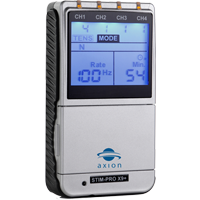TENS application for tension headaches

If those affected suffer from tension headaches, they usually complain about pain that wraps around the head like a band. This type of headache can be divided into episodic and chronic forms. The episodic headaches last less than 15 days a month. The pain often starts a few hours after waking up and gets worse as the day goes on. The chronic headaches last at least 15 days a month and are present regardless of the time of day. You can relieve the pain with TENS pain therapy [1].
The pain stimulus is not passed on to the brain by the electrical impulses from a TENS device. The stimulation current can also stimulate the body to release endorphins[2]. These are endogenous hormones that have a pain-relieving effect. The TENS treatment also promotes blood circulation[3].

-

This guide is for orientation purposes and does not replace the supervision of a doctor or therapist. Please follow the warnings and safety instructions of your device. Changes and errors are possible.
-

Number inside the circle: Channel number
Circle color: Red = Electrode 1, Black = Electrode 2
The recommended programs for axion TENS devices
-

STIM-PRO X9B
STIM-PRO X9B Details -

STIM PRO X9+
STIM-PRO X9+ Details -

STIM-PRO Comfort
STIM-PRO Comfort Details -

STIM-PRO Eco*
STIM-PRO Eco Details
*The STIM-PRO Eco is a manual TENS device. If you have not received parameter settings from your therapist, please use a frequency range between 70 and 120 Hz (burst mode 2 Hz) and a pulse width range between 150 µs and 200 µs.
Please note when using TENS:
The intensity should be adjusted so that it is felt as a pleasant tingling sensation. The duration of the application should be approx. 40 minutes in order to be able to achieve a lasting reduction in pain. It also makes sense to switch programs every now and then.
The advantages of pain treatment with TENS
-

From everywhere
You can use TENS therapy anywhere. It doesn't matter whether you're sitting comfortably on the sofa or in the office.
-

Drug free
TENS pain therapy is an alternative to drug pain treatment
-

At any time
You can use TENS flexibly and at any time. Success can already be achieved after the first treatment
-

Free of side effects
When used correctly, pain treatment with TENS has practically no side effects
Studies and scientific sources








